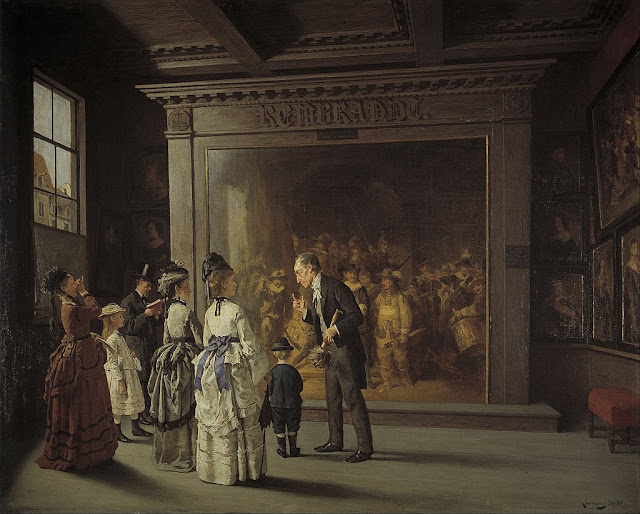No is one of the most important words in the English language. Very useful & I use it a lot. But without the N, it would just be O.
Other words I like beginning with N are nuisance, never, nosy & numbskull.
The art world has other ideas…
N
1. An Artist (Nantembō): The Stick of Nantenbo by Nakahara Nantenbō (1839-1925)
A Zen Buddhist monk, Nakahara Natenbō is said to have beaten his students with a nanten tree stick that he’d cut himself. This 1901 painting includes a message reading how many whacks of said stick you’d receive should you speak. It goes on to inform you how many wallops you’d get if you don’t speak. I’m no Zen Master, so make of this what you will.
2. An Artwork (Night Watch): The Night Watch by Rembrandt van Rijn (1606-1669)
This, one of Rembrandt’s most famous & celebrated paintings also goes by the name of “Militia Company of District II under the Command of Captain Frans Banninck Cocq” or “The Shooting Company of Frans Banning Cocq & Willem van Ruytenburch.” If you’ve ever seen been fortunate enough to see it in “person,” you’ll know that it’s enormous. At this time, you’d pay to get into a painting. As an artist, you’d get the commission & everyone that would appear in the picture would have to pay their share to have their portrait included. There are lots of things to know about “The Night Watch,” one of which is it’s got nothing to do with night; the bad varnish job it had previously made it appear darker & therefore a night-time image. Another is that it appeared in an 1885 painting by August Jernberg (1826-1896). Today’s final fun fact is that Rembrandt painted the drummer for free.
3. A Bird (nightjar): Nightjar by Jim Moir (b. 1959)
Jim Moir started life on UK television as comedy genius Vic Reeves & is now back on UK television as something of a bird-painting genius. This beautiful nightjar painting gives an impression of the bird’s inherent weird, unevolved appearance & baby-bird gape. The nightjar has incredible markings to camouflage itself when nesting on the ground but the artist eschews this in favour of the form, proportions & frankly, whiskers (rictal bristles).
4. An Art Movement (Naïve Art): The Repast of the Lion by Henri Rousseau (1844-1910)
There are varying degrees of Naïve Art in my opinion. Rousseau is possibly at the top end, where there looks to be some practised & disciplined effort & talent at work. Otherwise, Naïve Art is typified by simple works whose meaning is non-existent or very much on the surface. It therefore does away with snobbery & traditional methods or standards. Anyway basically the lion’s “repast” is a crocodile. He’s eating a crocodile.
5. A Biblical Figure (Noah): Noah’s Ark by Alfred Wallis (1855-1942)
Still in the land – or ocean - of Naïve Art, but less at the Rousseau end, if you know what I mean…
6. A Country (Nigeria): Northern Nigerian Landscape by Uzo Egonu (1931-1996)
I love this work by Uzo Egnou in almost monochromatic, earthy colours. I like the patterns within what looks at first glance like a pattern. The image reflects Egonu’s recollections of being brought up in a Nigerian village & has a graphic rather than realistic effect; it reminds me of the way our memories seem to simplify snapshots of events or places over long periods of time.
7. A Body Part (navel): Torso, Navel, Mustache-Flower by Jean Arp (1886-1966)
It seems unsurprising that Arp was a Dadaist & I do find the “navel” quite funny. He avoided being recruited into the German army by successfully feigning mental illness.
8. An Animal (newt): Newt Pond by Eric Ravilious (1903-1942)
Sadly Ravilious didn’t avoid the UK military. Anti-fascist even before the war, he became a war artist, even making drawings from the cockpit of planes. He was lost in action whilst flying to find another lost RAF plane. Although there are no newts visible here - & some might say I’ve cheated, others that the newts can be said to be simultaneously in & not in the picture – Ravilious was a terrific painter & engraver.
9. An Object (notes): Vincent van Gogh’s notes (letters) (1853-1890)
Again, it’s a little cheat, but Vincent’s letters to his long-suffering brother are legendary. He’d litter his notes with drawings. There exist 820 letters written by Vincent, most of them to Theo.
10. A Plant (nasturtiums): Nasturtiums by Emmanuel Phillips Fox (1865-1915)
Australian Impressionism? Don’t mind if I do! After attending art school in Melbourne, Fox travelled to Europe, studying at the top art schools in Paris before returning to Melbourne to open his own. Full of the concepts & practises he’d learned in Europe, he established the Melbourne School of Art in 1892. If you know nasturtiums, you'll be able to smell this image...








.jpg)



Comments
Post a Comment